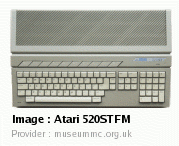|
About the Atari 520STFM...
 In Europe, Atari had only achieved fair to middling success with their previous home microcomputers, their major successes having been in the video games market. In 1985 that changed with the very successful ST range. This machine, the 520STFM is amongst the first in that range, being only a slight derivative of the original 520ST. When the ST was launched the so called 'golden age' of Atari was well and truly over, financial difficulties and boardroom upheavel had left the company a pale shadow of its former self. That said, the ST helped to delay Atari's eventual demise for a good few years. The ST was the first new Atari product during the companies stewardship by Jack Tramiel, who had left Commodore only months previously. Tramiel naturally wanted to beat Commodore at their own game (they didn't part amicably) and was aware of Commdore's interest in releasing a 16 bit home computer and more importantly, their interest in Amiga Inc. who had the technology they needed. Tramiel first loaned Amiga Inc. money to continue developing the Amiga and then attempted to license the technology for what became the ST. Sadly for Tramiel, Commodore were eventually successful in licensing the Amiga techology and bought the Commodore Amiga to market. Atari had to look elsewhere, they turned to Digital Research and bought out the ST featuring the GEM graphical operating system (ported to the Motorola 68000 processor) on top of a low level component called Atari TOS which managed the ST's hardware. In Europe, Atari had only achieved fair to middling success with their previous home microcomputers, their major successes having been in the video games market. In 1985 that changed with the very successful ST range. This machine, the 520STFM is amongst the first in that range, being only a slight derivative of the original 520ST. When the ST was launched the so called 'golden age' of Atari was well and truly over, financial difficulties and boardroom upheavel had left the company a pale shadow of its former self. That said, the ST helped to delay Atari's eventual demise for a good few years. The ST was the first new Atari product during the companies stewardship by Jack Tramiel, who had left Commodore only months previously. Tramiel naturally wanted to beat Commodore at their own game (they didn't part amicably) and was aware of Commdore's interest in releasing a 16 bit home computer and more importantly, their interest in Amiga Inc. who had the technology they needed. Tramiel first loaned Amiga Inc. money to continue developing the Amiga and then attempted to license the technology for what became the ST. Sadly for Tramiel, Commodore were eventually successful in licensing the Amiga techology and bought the Commodore Amiga to market. Atari had to look elsewhere, they turned to Digital Research and bought out the ST featuring the GEM graphical operating system (ported to the Motorola 68000 processor) on top of a low level component called Atari TOS which managed the ST's hardware.
There was a great deal of rivalry between both companies and even the users of each machine with constant arguments about which machine was best for most of the rest of the decade. During these ST vs. Amiga wars one of the biggest criticisms levelled by those on the Amiga side was that the ST was largely constructed from 'off the shelf' components, unlike the Amiga which was an almost completely custom machine. That might be true, and no-one doubts the ingenuity of the Amiga's chipset, but bear in mind that Atari bought this machine from drawing board to shop floor in 12 months. Quite an achievement, especially when you consider that the ST could compete and matched the Amiga, which had been in development for almost 5 years, in many departments.
Atari kept the same styling for the ST as they had been using for some time on their 8 bit machines. The ST sported the same row of recessed function keys, the same green power LED on the front left corner, and the same 'grill' style to the plastic on the top of the machine. This may also have lowered development costs. Many criticise the ST's build quality, and certainly the cases are a bit creaky, but it was never intended to be used in a setting that would require industrial strength!
The ST featured the Motorola 68000 processor at 8MHz, had 512Kb of RAM, a pallette of 512 colours, and featured a MIDI interface and built-in 3.5" disk drive so it was fairly powerful for 1985. This led to Atari's (typically Tramielean) catchphrase of "power without the price". At around GB£750 for the 520ST it was easy to see that they meant it. A wide range of software became available for the ST including CAD, office applications, and development tools although it is best remembered as a games machine and for Cubase, the MIDI sequencing software which was extemely popular amongst musicians.
|



